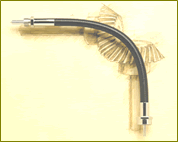Benefits of Flexible Shaft Technology
Flexible shafts are a preferred rotary motion transmission device because they:
-
Eliminate alignment problems: Flexible Shafts have no need for the tight tolerance that solid shafts require.
-
Have Higher efficiency: Flexible Shafts are 90 %-95% efficient. Gears, U-Joints, Belts and Pulleys have much lower efficiencies due to greater frictional losses.
-
Are Light weight and powerful: Flexible Shafts have a 3:1 weight advantage over other design solutions while transmitting greater power loads.
-
Reduced parts cost: Bearings and housings for Solid Shafts and Gears require precise machining operations. Flexible Shafts eliminate the need for such demanding tolerance and their excessive costs.
-
Are Easy to Install: Need no special installation tools.
-
Are Not affected by Vibration: Vibrations do not affect flexible Shafts performance.
-
Provide Greater design freedom: Limitless possibilities in position motor and driven components
-
Allow Large off-sets: Flexible couplings allow only 5 degrees of off-set and U-Joints 30 degrees, but with a 40%-50% decline in efficiency. Flexible shafts permit a full 180 degree off-set while maintaining their high efficiency.
-
Have Lower installation cost: Flexible Shafts install in minutes without special tools or skills. Solid Shafts, Gears, Pulleys, and Universal Joints require precise alignment and skilled mechanics for their installations.
-
Can Be Designed At The Latter Stages Of A Project: Unlike other rotary motion devices that need to be designed around because of their rigidness, defined configurations, and large mass. Flexible Shafts allow greater design freedom since engineers have only one piece to work on, eliminating complex coordination of multiple pieces
Versatile Flexible Shafts
Flexible Shafts are often the preferred choice for rotary motion transmission over:
Gear boxes, Universal joints, and Belts-and-pulleys in both Industrial and Medical applications.
Flexible Shafts vs Gear Boxes
Flexible Shafts vs Universal Joints
Flexible Shafts are preferred over gear boxes because they:
-
are more economical for right angle bends
-
are more efficient
-
are less noisy
-
occupy less space
-
are easier to install-need no special skill or special tools
-
require looser tolerancing
-
do not require expensive couplings that gearboxes often need
Flexible Shafts are preferred over universal joints as they:
-
are less expensive
-
have fewer components
-
are more efficient
-
do not require tight mounting tolerances unlike universal joints
-
have constant angular velocity
-
require minimal maintenance
-
make very little noise


Universal joints can be off-set only up to 15-20 degrees after which the change in angular velocity becomes objectionable.
In universal joints, more components are needed beyond 20 degree offsets, adding to cost and space requirements.
Flexible Shafts go up to 90 degrees without any discernible change in performance or additional components.




